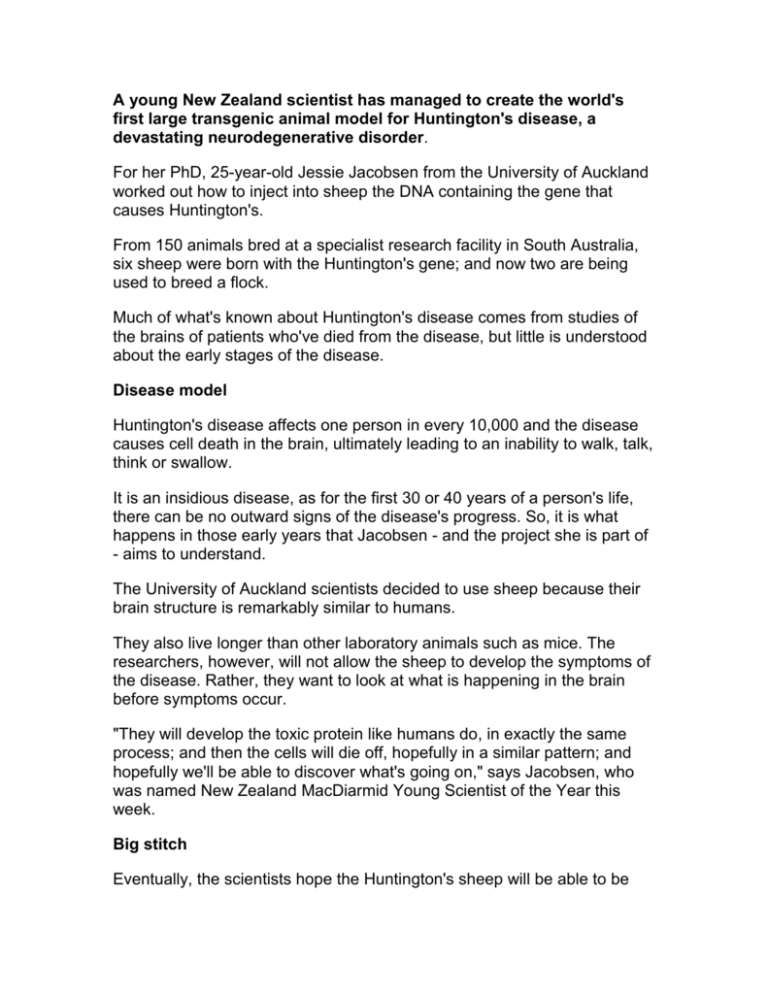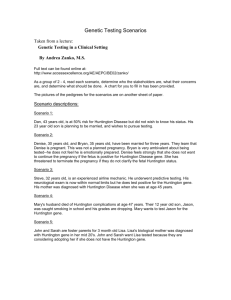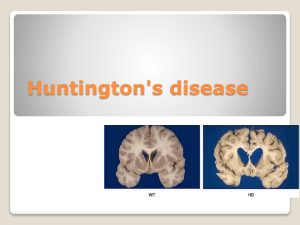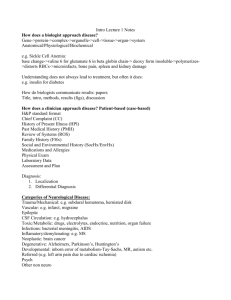first large transgenic animal model for Huntington`s disease
advertisement

A young New Zealand scientist has managed to create the world's first large transgenic animal model for Huntington's disease, a devastating neurodegenerative disorder. For her PhD, 25-year-old Jessie Jacobsen from the University of Auckland worked out how to inject into sheep the DNA containing the gene that causes Huntington's. From 150 animals bred at a specialist research facility in South Australia, six sheep were born with the Huntington's gene; and now two are being used to breed a flock. Much of what's known about Huntington's disease comes from studies of the brains of patients who've died from the disease, but little is understood about the early stages of the disease. Disease model Huntington's disease affects one person in every 10,000 and the disease causes cell death in the brain, ultimately leading to an inability to walk, talk, think or swallow. It is an insidious disease, as for the first 30 or 40 years of a person's life, there can be no outward signs of the disease's progress. So, it is what happens in those early years that Jacobsen - and the project she is part of - aims to understand. The University of Auckland scientists decided to use sheep because their brain structure is remarkably similar to humans. They also live longer than other laboratory animals such as mice. The researchers, however, will not allow the sheep to develop the symptoms of the disease. Rather, they want to look at what is happening in the brain before symptoms occur. "They will develop the toxic protein like humans do, in exactly the same process; and then the cells will die off, hopefully in a similar pattern; and hopefully we'll be able to discover what's going on," says Jacobsen, who was named New Zealand MacDiarmid Young Scientist of the Year this week. Big stitch Eventually, the scientists hope the Huntington's sheep will be able to be used to test drugs. "Because sheep live for 10 to 15 years, we are hopefully going to have at least a two-year pre-symptomatic window though which we can trial drugs to see if they can halt the disease before the symptoms start," Jacobsen told BBC News. Jacobsen (R) and colleagues caution there is much work ahead The sheep - the first Huntington's sheep are just a year old - are the culmination of a project that started about eight years ago. Jacobsen's part - the tricky creation of the transgene - took a year of hard slog. It was difficult because the Huntington's gene is about 10 times larger than the average human gene. In those who will develop Huntington's, there are extra repeats of the CAG "letters" of the genetic alphabet. Drug testbed "It's a very large gene," said Auckland Professor of Anatomy, Richard Faull, one of the supervisors of Jacobsen's work. "It's an unstable gene. It's a very toxic gene, too. That's probably why it hasn't been done before." But, he added, although it was early days for Jacobsen's work "the milestones are being checked off". "The beauty of this model is that we will be able to look at the very earliest stages of the onset of the disease because that's when you're going to have to go in and get this gene - turn it off, turn it down, not make it so hostile, as well as preserving its normal functions," Professor Faull said. Jo Dysart is from the Huntington's Disease Association (Auckland). She works with affected families. She commented: "This animal is going to provide an incredibly useful genetic model for Huntington's disease and it's going to provide us with an opportunity to use it to trial drugs which will have potential benefits in humans."









